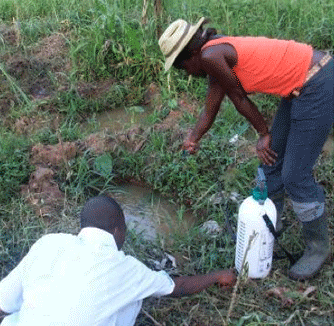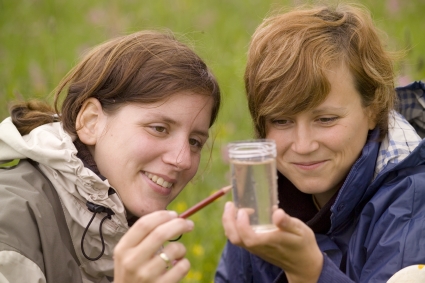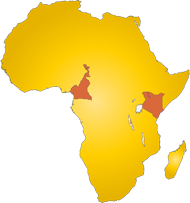

Developing a new strategy for integrated mosquito control
The most popular strategy to control mosquitoes on a large scale relies on the application of pesticides, both against larvae and adults. Sometimes accompanying actions are conducted, like residual indoor spraying and the use of insecticide treated bed nets or personal protection agents. After the dramatic environmental damages due to the initial use of long living pesticides such as DDT in the middle of the 20th century, pesticides in use for mosquito control today are usually readily degradable to prevent bioacumulation and negative effects from long term contamination. However, this typically causes a short action time and the necessitiy of frequently repeated applications, with all the environmental problems mentioned before.
Biological control approaches as an alternative have usually concentrated on the introduction of predators. However, most mosquito species typically breed in more or less temporary ponds where they escape efficient predators which need stable conditions for a sufficient time to establish [1]. Instead, Meyabeme Elono et al. (2010) showed that the abundance of mosquito larvae in German wetlands could be much better explained by the presence of small crustaceans being competitors, than by the presence of predator species [2]. Most mosquito species are considered to be inferior competitors, which quickly colonize young ponds and finish their larval development before the competitive pressure of controphic species is rising too much. Later the appearance of larger predators minimizes both the mosquito larvae and their controphic species.
Additionally, Liess et al. (2002) showed with water fleas (Daphnia magna) that the reduction of intraspecific competition after the application of a pesticide can lead to an overshoot in the population size afterwards [3]. In following experiments, simulated predation after a pulse contamination let the surviving animals grow faster [4], whereas the addition of an interspecific competitor caused a strongly decreased recovery of the population size [5]. In 2011, Duquesne et al. showed in a microcosm experiment that the density of a macrozooplankton community strongly affects the colonization of ponds by mosquitoes as well as their larval development. With a fully established community at carrying capacity present, oviposition was suppressed completely [6].
Considering those results, promotion of a makrozooplankton community appears promising to control mosquito larvae. Kröger et al. (submitted) treated young temporary ponds in German wetlands with crustaceans collected at older ponds nearby and compared the results with the application of the biological agent B.t.i. Immediately after B.t.i. treatment the larval mosquito populations were strongly reduced, but recovered within 2 -3 weeks due to a fast recolonization. The teatment with competitors caused a slower, but consistent reduction of mosquito larvae which reached its maximum after 3 weeks. In anthropogenic ponds in Cameroon, Meyabeme Elono (submitted) found a similar pattern and showed that the best results are achieved by a combination of an initial B.t.i. treatment an the addition of competitors directly afterwards.
[1] Chase J.M., Knight T.M. (2003):![]()
![]() Drought-induced mosquito outbreaks in wetlands. Ecol Lett 6 (11), 1017-1024.
Drought-induced mosquito outbreaks in wetlands. Ecol Lett 6 (11), 1017-1024.
[2] Meyabeme Elono A.L., Liess M., Duquesne S. (2010): ![]()
![]() Influence of competing and predatory invertebrate taxa on larval populations of mosquitoes in temporary ponds of wetland areas in Germany. J Vector Ecol 35 (2), 419-427.
Influence of competing and predatory invertebrate taxa on larval populations of mosquitoes in temporary ponds of wetland areas in Germany. J Vector Ecol 35 (2), 419-427.
[3] Liess M. (2002): ![]()
![]() Population response to toxicants is altered by intraspecific interaction. Environ Toxicol Chem 21 (1), 138-142.
Population response to toxicants is altered by intraspecific interaction. Environ Toxicol Chem 21 (1), 138-142.
[4] Liess M., Foit K. (2010): ![]()
![]() Intraspecific competition delays recovery of population structure. Aquat Toxicol 97, 15-22.
Intraspecific competition delays recovery of population structure. Aquat Toxicol 97, 15-22.
[5] Foit K., Kaske O., Liess M. (2012): ![]()
![]() Competition increases toxicant sensitivity and delays the recovery of two interacting populations. Aquat Toxicol 106-107, 25-31.
Competition increases toxicant sensitivity and delays the recovery of two interacting populations. Aquat Toxicol 106-107, 25-31.
[6] Duquesne S., Kroeger I., Kutyniok M., Liess M. (2011): ![]()
![]() The Potential of Cladocerans as Controphic Competitors of the Mosquito Culex pipiens. J Med Entomol 48 (3), 554-560.
The Potential of Cladocerans as Controphic Competitors of the Mosquito Culex pipiens. J Med Entomol 48 (3), 554-560.



